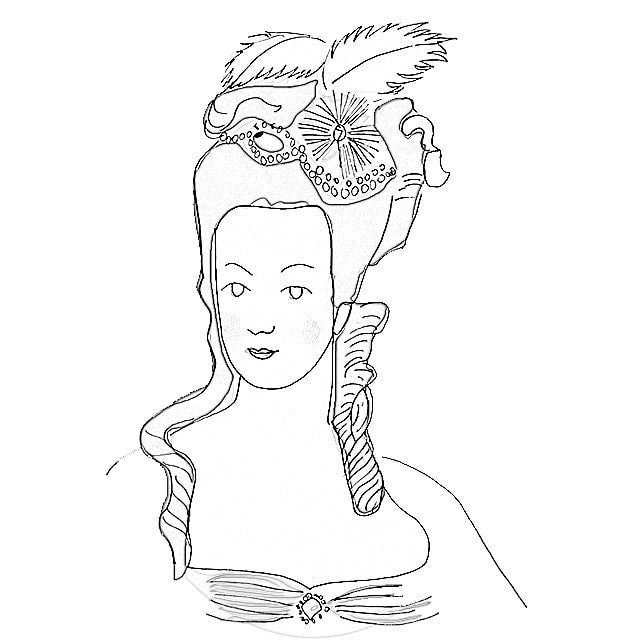Infatuated with history, beauty…And the history of beauty, my dearest wish is to offer you, through Mademoiselle Saint Germain cosmetics, the best of the plant kingdom. My association with the Potager du Roi de Versailles to supply me with plants is therefore not a coincidence… But it sounds like a no-brainer for me who feels so much admiration for Marie-Antoinette, great lady of another time also fond of natural beauty! Indeed, this young queen, and with her her beauty secrets, is at the origin of a real upheaval in the cosmetic practices of the time (which then consisted only of masking dirt and odors)!
Before Marie-Antoinette: Make-up and perfumes
Before the "vegetable revolution" initiated by Marie-Antoinette, beauty as conceived by the Court of the Palace of Versailles consisted of two words: make-up and perfume. This is how the Court of Louis XV was nicknamed "Cour Parfumée" in reference to the Marquise de Pompadour, reputed to spend colossal sums of money in... Perfumes! Perfumes which were not then thought of as tools of seduction intended to enhance beauty but used to mask body odors...
They were also attributed purifying properties, the belief that they helped get rid of miasmas (putrid odors). Indeed, despite the luxury and refinement of Versailles, bathing was not part of the customs: the subjects had recourse to the "dry toilet", changing their clothes about ten times a day. Everything was perfumed: gloves, hair, clothes, handkerchiefs...
Blush, too, had a good press at the time, for similar reasons: its primary purpose was indeed to hide the grime accumulated from the lack of grooming, which is why both men and women wore it! However, it had real deleterious effects for the skin, being composed of white lead and mercury salts. And the more the skin was irregular, by dint of using and abusing it, the more it was applied to the skin to hide these imperfections...
This is how, at only 36 years old, Madame de Pompadour was already totally disfigured! This did not prevent the courtiers of Louis XV from using again and again these substances which were nevertheless harmful to the skin. And this is also what prompted Marie-Antoinette – beyond her love for botany – to bring plants up to date, when it comes to cosmetics.
Marie-Antoinette: natural cosmetics in the spotlight
Arriving in Versailles in 1770 at the age of only 14, Marie-Antoinette breathes the wind of a return to nature. Under his leadership, the "dry toilet" was abandoned in favor of "la toilette de Flore", whose fame was such that it gave its name to a work by Pierre-Joseph Buc'Hoz, a famous botanist of the time. . And, in line with this return to nature, cosmetic formulas based on minerals – including those that made up make-up, therefore – are abandoned in favor of natural beauty products based on plant extracts.
If many works of the time compile the recipes that sign the revival of natural cosmetics, it is to Jean-Louis Fargeon, the perfumer of Marie-Antoinette himself, that we owe the most complete collection.
And, to immerse yourself in these beauty secrets, what better than an extract from the book "Jean-Louis Fargeon, perfumer of Marie-Antoinette" (Elisabeth Feydeau, Editions Perrin, 2005)? Selected pieces :
For Marie-Antoinette, Fargeon made above all spirituous waters of rose, violet, jasmine, daffodil or tuberose obtained by distillation (...) He intensified them with musk, amber or the opopanax.
She took great care of her complexion. Pigeon cosmetic water cleansed the skin, charms water made with the tears of the vine flowing in May, toned it. Angel water whitened it by purifying the complexion. Marie-Antoinette, whose complexion was admirable, had no need of the water of Ninon de Lenclos supposed to preserve youth.
She coated her hands with the Royal paste which maintained their softness and prevented chapping. She adored rose, vanilla, frangipane, tuberose, carnation, jasmine and mille-fleur pomades. For the bath, she used soaps with herbs, amber, bergamot or potpourri, and to maintain the shine of her teeth, she ordered powders and opiates.
Aren't these few lines alone a first glimpse of Marie Antoinette's many secrets to enhancing her beauty? If all of them no longer seem adequate today given the evolution of knowledge, some of them still seem worth mentioning to me... And why not made at home! Thus, the recipes for ointment with rose, vanilla, frangipane, tuberose, carnation, jasmine, mille-fleurs, which we will have the leisure to detail over time.
But for now, how about we start by looking at 3 iconic beauty recipes from the young queen?
Recipe #1: Cosmetic pigeon water to cleanse the skin
Its evocative name could discourage more than one, and yet it is indeed a cosmetic water used by Marie-Antoinette to cleanse her skin...

Recipe #2: Eau d'Ange to purify the complexion
Pigeon water already marks a first step towards the return to nature, of course! Nevertheless, my heart leans - dare I say, without hesitation - towards angel water, which is used to purify the complexion:

Recipe #3: The royal paste for the hands to prevent chapping
If the skin of our face deserves of course all our attention, Marie-Antoinette also made it a point of honor to protect her hands from the harshness of the cold seasons (a recipe that comes at the right time with the beginnings of autumn, not ?):

If these three recipes allow us to get a first idea of the richness of natural cosmetics under the Court of Marie-Antoinette, it's not over: little by little, I will reveal other beauty secrets of the young queen. to whom we owe the genesis of natural cosmetics. But first, I suggest you dive back 100 years earlier with the story of the beauty secret that gave birth to the first range of Mademoiselle Saint Germain cosmetics

